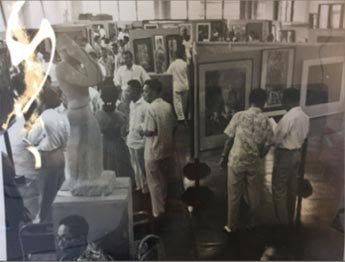Five Minutes with Southeast of Now March 24, 2017 11:00
 This month marks the official launch of Southeast of Now: Directions in Contemporary and Modern Art in Asia, a new journal devoted to art in Southeast Asia (and the wider region). The journal's inaugural issue has been launched at several events across Southeast Asia, engaging scholarly as well as artistic and curatorial publics.
This month marks the official launch of Southeast of Now: Directions in Contemporary and Modern Art in Asia, a new journal devoted to art in Southeast Asia (and the wider region). The journal's inaugural issue has been launched at several events across Southeast Asia, engaging scholarly as well as artistic and curatorial publics.
In January, the journal had a soft launch that coincided with the Singapore Biennale Symposium at the National Museum of Singapore, and an informal launch was held earlier this month at the Jim Thompson Art Center in Bangkok to coincide with the exhibition People, Money, Ghosts (Movement as Metaphor).
In this edition of Five Minutes with …, we caught up with the editorial collective—Isabel Ching, Thanavi Chotpradit, Brigitta Isabella, Eileen Legaspi-Ramirez, Yvonne Low, Vera Mey, Roger Nelson, Simon Soon, and Vuth Lyno—to discuss the complexities of an exisiting “gap” about contemporary art in Southeast Asia, the decision to have a thematic focus of “discomfort”, and what readers can expect in future issues of Southeast of Now.
In the editorial to this inaugural issue of Southeast of Now, you express a desire to address a gap in current scholarship about contemporary art in Southeast Asia. Could you briefly account for the nature and complexities of this gap? Why aren’t enough people writing about contemporary art in the region and, even so, why aren’t writers framing their research “historically”?
Yvonne Low: Saying that there is a gap in current scholarship about contemporary art in Southeast Asia does not mean that there aren’t any writings on and about the contemporary; on the contrary, there are a lot. Such writings however are frequently curatorially driven or biennially-driven (if such a term maybe used). In some instances, such as in Indonesia, writings on contemporary art are commissioned by collectors. For all these reasons, research and writing on contemporary art in Southeast Asia are often skewed toward particular collections, personal or public; they may be responding to particular themes or have had to meet particular objectives. With the exception of the rare few publications (for example,T. K Sabapathy's Intersecting Histories: Contemporary Turns in Southeast Asian Art) that make a serious attempt to look at the region’s contemporary art historically, mapping commonalities and shared pasts, and identifying intersections and inter-/intra-regional developments, the far more common approach taken of contemporary is to view it as ahistorical, an artistic phenomenon that does not have any precedence, when this is clearly not true. And especially not when conditions that led to the rise of contemporary art in the region was traceable to as early as the seventies.

The First Southeast Asia Art Competition Exhibition, Manila, 12 May 1957
(Courtesy of Vanessa Ban. Original Source can be found in the MoMA Archives, New York IC/IP I.A.408)
You settled on “Discomfort” as the theme for the first Call For Papers. What sort of provocations did you hope to invite?
Editorial Collective: To adapt the words used in the Call For Papers and the editorial from the inaugural issue, the provocations that the Southeast of Now editorial collective wanted to invite were pieces that reflect on the burdens and future possibility of wielding “regionalism” as a framework. The playful disquiet evoked by the title of the journal, which troubles linear notions of space-time and destablises any certainty of an imagined temporal centre, gave rise to the first theme. “Discomfort” locates this source of tension and anxiety as a productive register to explore various discursive stakes, propelled by new urgencies, orientations, and motivations; and perhaps discover therein some comfort, even if merely within shared discomfort.

Image from Sharmini Pereira with P. Kirubalini, “Searching for Discomfort” (an essay from the inaugural issue of Southeast of Now)
Alongside traditional academic writing, the Artists’ Projects section in this issue features fascinating work by artists such as Shooshie Sulaiman, who is based in Kuala Lumpur, and a transcribed conversation between artist Tom Nicholson, curator Grace Samboh and the late Edhi Sunarso, who was supposedly “Sukarno’s most trusted sculptor”. How do you see this section evolving as a space for creating discourses about contemporary Southeast Asian art? What, in your opinion, are the curatorial possibilities here?
Vera Mey: It was important for us to create an open platform within the journal where we could pair artistic responses to the various journal themes we have planned. We also wanted to have the possibility for an artistic response which could be purely visual alongside more scholarly articles and written work. A lot of contemporary artists are engaged in artistic research and have different ways of demonstrating this beyond writing an article, essay or review. In the case of the transcript in the video work by Tom Nicholson with Grace Samboh we also wanted a place where this kind of research material, in this case generated from an interview of a video work, could travel beyond the site of the physical exhibition in which it was originally viewed, which was the Jakarta Biennale. Within the context of the journal it is not only an artwork to be experienced; it is also a primary source of research material about an aspect of Indonesia's art history.
There are endless curatorial possibilities here. The artists' pages could be a space for a specifically curated space of images or texts either by a member of the editorial collective, a guest curator, or someone with a desire to respond to our call for proposals. This follows new approaches to publishing where printed matter is considered equally an exhibitionary format in two-dimensional form. In future issues we will also alternate between archival pages from various archives within and beyond the region and the artists’ pages.
With the opening of National Gallery Singapore in 2015 and the upcoming opening of Museum of Modern and Contemporary Art in Nusantara (Museum MCAN) in Jakarta, it appears as if substantial investments, whether from public institutions or private individuals, are being channeled to the area of contemporary art. Where do you think a journal of critical scholarship such as Southeast of Now might fit, given its context?
Brigitta Isabella: The infrastructure of public and private institutions in Southeast Asia cannot be generalized as having similar nature and agendas. Its characters are contingent on the context of relationship between artists, curators, the state and the market inside the local art scene. Within this context, there are different power plays shaped by politics of nationalism, commercialization of art and commodification of culture, as well as narratives of resilience from minor artists and alternative spaces that also greatly contribute to the practice of contemporary art. Framing an apt critique of art institution in the region certainly cannot follow the discourse of institutional critique within the Western art system and here the journal is trying to present a necessarily historical perspective to understand the shifting cultural context in Southeast Asia. Another fact to consider is the lack of educational infrastructure of art history in most countries in Southeast Asia, so, in a way, the journal serves as a trans-local container and a discursive space for creating encounters between critical scholarships of contemporary and modern art produced in, from and around the region.
What other conversations do you foresee happening within the pages of future volumes of Southeast of Now?
Roger Nelson: The categories of “contemporary and modern art,” indeed of “art” in general, are obviously terms we consider to be open for debate just as much as the category of “Southeast Asia” itself. Given this, we anticipate continuing to trouble and denaturalise these categories, including through looking at aspects of culture that don't usually qualify as “art,” and also through treating the region's borders as fluid, and looking at research that transcend these borders.
But in all this, we remain committed to the importance of an historical approach, however interwoven with methodologies from other disciplines and practices that historical approach might also be. We would be delighted if future issues of the journal can look further back in time, to the 19th century (and before), and perhaps can place this historical research in dialogue with issues of today (and the future).

To find out more about submission guidelines and subscription information, visit www.southeastofnow.com or the NUS Press Southeast of Now page.
